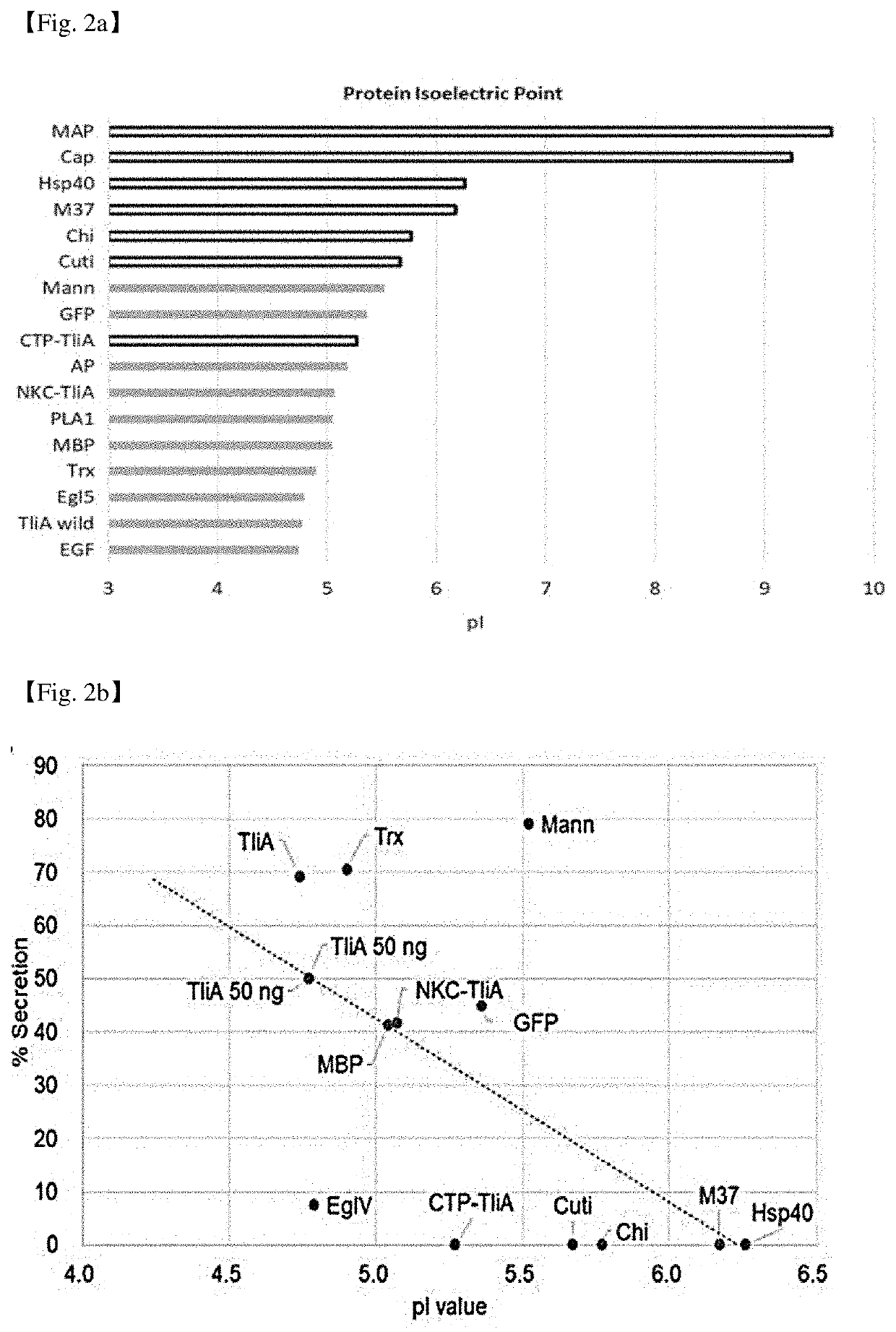Extracellular secretion of target protein
a target protein and extracellular technology, applied in the field of extracellular to achieve the effect of effective secretion of target proteins and simple and efficient mass production of proteins
- Summary
- Abstract
- Description
- Claims
- Application Information
AI Technical Summary
Benefits of technology
Problems solved by technology
Method used
Image
Examples
example 1
[Example 1] Bacterial Strains and Growth Media
[0120]Plasmid construction and gene cloning were performed in E. coli XL1-BLUE. Protein expression and secretion were observed in the P. fluorescens ΔtliA ΔprtA strain, which is a double-deletion derivative of P. fluorescens SIK-W 1 (Son, M., Moon, Y., Oh, M. J., Han, S. B., Park, K. H., Kim, J G., and Ahn, J. H. (2012) Lipase and protease double-deletion mutant of Pseudomonas fluorescens suitable for extracellular protein production. Appl Environ Microbiol 78, 8454-8462). Microorganisms were cultured in lysogeny broth (LB) with 30 μg / ml kanamycin. An enzyme plate assay for the target genes with lipase activity (TliA, NKC-TliA, and CTP-TliA) was prepared with LB agar media containing blender-mixed 0.5% colloidal glyceryl tributyrate. E. coli and P. fluorescens were incubated at 37° C. and 25° C., respectively. E. coli transformation was performed following the standard heat-shock method, and P. fluorescens transformation was performed vi...
example 2
[Example 2] Plasmid Vector Constructions
[0121]Plasmid pDART was used for the secretory production of different proteins of the present inventors (Ryu, J., Lee, U., Park, J., Yoo, D. H., and Ahn, J. H. (2015) A vector system for ABC transporter-mediated secretion and purification of recombinant proteins in Pseudomonas species. Appl Environ Microbiol 81, 1744-1753). Plasmid vectors pFD10 and pBD10 were derivatives of pDART, constructed by adding codons for 10 aspartic acid residues to the target proteins in either the upstream or downstream position of MCS. The DNA sequence for 10 aspartic acids was amplified via PCR using synthesized Glycine max lunasin gene (Galvez, A. F., Chen, N., Macasieb, J., and de Lumen, B. O. (2001) Chemopreventive Property of a Soybean Peptide (Lunasin) That Binds to Deacetylated Histones and Inhibits Acetylation. Cancer Research 61, 7473-7478) as a template. Two different PCR products were obtained, each for pFD10 and pBD10. One or two arbitrary bases are i...
example 3
[Example 3] Construction of Plasmids with Inserted Target Genes
[0126]Thirteen target genes were selected for pDART insertion. The genes were amplified with PCR from extracted genomic DNA samples (TliA, MBP, Trx, and Hsp40), total cDNA (Eg1V), synthesized DNA products (NKC-TliA, CTP-TliA, MAP, lunasin, lunasin derivatives, GFP, and supercharged GFPs), or plasmids (other proteins), or the like.
[0127]Their N-terminal signal peptides were detected with the SignalP 4.1 web-based prediction algorithm (http: / / www.cbs.dtu.dk / services / SignalP / ) (Petersen, T. N., Brunak, S., von Heijne, G., and Nielsen, H. (2011) SignalP 4.0: discriminating signal peptides from transmembrane regions. Nature methods 8, 785-786) and were excluded from cloning and expression processes. For synthetic genes, the codons were optimized for either E. coli expression (supercharged GFPs) or P. fluorescens expression (TliA derivatives).
[0128]The lunasin gene was synthesized and amplified with PCR for pDART insertion. Wi...
PUM
| Property | Measurement | Unit |
|---|---|---|
| Structure | aaaaa | aaaaa |
| Fluorescence | aaaaa | aaaaa |
Abstract
Description
Claims
Application Information
 Login to View More
Login to View More - R&D
- Intellectual Property
- Life Sciences
- Materials
- Tech Scout
- Unparalleled Data Quality
- Higher Quality Content
- 60% Fewer Hallucinations
Browse by: Latest US Patents, China's latest patents, Technical Efficacy Thesaurus, Application Domain, Technology Topic, Popular Technical Reports.
© 2025 PatSnap. All rights reserved.Legal|Privacy policy|Modern Slavery Act Transparency Statement|Sitemap|About US| Contact US: help@patsnap.com



